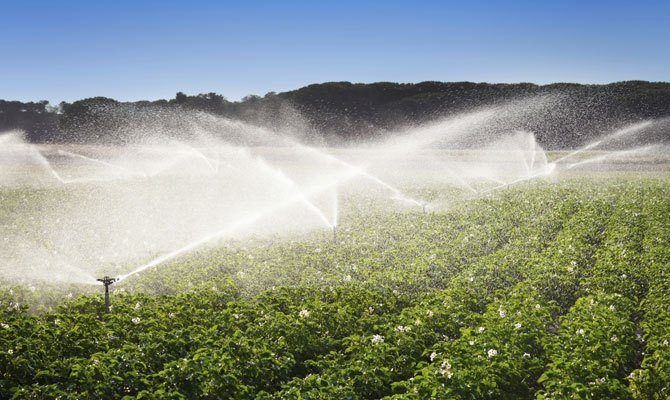It Takes A Lot Of Water To Keep Us Fed
This is one in a series of stories; visit The Daily Meal Special Report: Water for more.
Many foods naturally contain a lot of water; fruits and vegetables tend to carry the most. A head of lettuce is 95 percent water, a watermelon is 93 percent water, broccoli contains 91 percent water. Dairy foods, too, are water-rich. Milk weighs in at 89 percent, yogurt 85 percent (Greek yogurt somewhat less).
Every time we eat, we're consuming water without realizing it — and not just from what's actually in our food. It takes water to grow, process, and package food, too. To produce enough food for the average American to enjoy a healthy diet takes roughly 1,000 gallons of water per day.
Consider the production of beef: It takes an average of three years to produce 200 kilograms (440 pounds) of beef. Over that period, a cow eats abouts 2,866 pounds of grains (i.e., oats and barley) and 15,873 pounds of roughage (i.e., pasturage and hay), all of which requires about 808,366 gallons of water to grow. Over its three-year growth period, the cow will itself drink another 6,340 gallons of water. Another 1,850 gallons of so will be used for farmhouse services and slaughtering processes. That all works out to about 1,850 gallons of water utilized for every pound of beef on your table.
When considering how much water went into growing and producing a food, Claire O'Connor, Agricultural Water Policy Analyst for the Natural Resources Defense Council, refers to the food chain: The lower down a food is on the food chain, the less water its production requires. A diet high in meat uses significantly more water than a vegetarian diet. A meat-eater's average daily water consumption is around 1,320 gallons; a vegetarian's is half that.
As noted, beef ranks high in terms of the amount of water required in production, but even apples — one of the foods that requires the least amount of water — drink in almost 100 gallons per pound. And then there's coffee, one of the world's most in-demand commodities: worse than beef, at 2,161 gallons per pound, not counting what you put into your coffee machine to brew a cup.
Our water footprint is measured by three categories: blue water (fresh water from rivers, lakes, and underground aquifers, used for drinking, washing, and industrial purposes like maintaining machinery), green water (evaporated water, soil water, or rain water, used mainly in agriculture), and grey water (polluted water that meets minimum water quality standards and is reused for various purposes). Agriculture uses about 70 percent of the available blue water — up to more than 90 percent in some developing countries. Groundwater depletion and drought contribute to water shortages. Growers and producers are using up water from underground aquifers faster than they can be refilled. And in 2015, Earth experienced the hottest year on record, causing extreme lack of growth in crops, particularly for corn and soybeans.
Standards are being written to address the issues of water stress, including the Alliance for Water Stewardship Global Water Stewardship Standard, which was created to define "a set of water stewardship criteria and indicators for how water should be stewarded at a site and catchment level in a way that is environmentally, socially, and economically beneficial."
Farmers and producers are stepping up to reduce water consumption through water-saving initiatives and processes. Farmers are switching to low-water practices like drip irrigation, irrigation scheduling, and regulated deficit irrigation. With drip irrigation, low volumes of water (21 percent less) are applied directly to crops' root zones rather than flooding the area between crop rows using traditional gravity irrigation. Irrigation scheduling tracks the amount of water crops take in, monitors weather and soil conditions, and times watering to match crop needs — reducing water use by 30 percent. Through regulated deficit irrigation, water applied during drought-tolerant stages is reduced, improving crop quality. In these ways and more, we are better regulating and reducing the use of water in the production of our food.
But we tend to forget about the water that is used to grow food that never finds its way onto our plates. "We end up wasting about 25 percent of fresh water on food that never gets eaten," says O'Connor. "So we're literally leaving water on the table." According to O'Connor, healthy soil is another factor in reducing our water waste as it can better hold and conserve water than soil that is exposed to pollutants and degraded. Increasing organic matter in soil by one percent can hold an additional 20,000 gallons of water in the top few inches of soil and will minimize the amount of irrigation water a farmer would need to apply later in the season.[pullquote:right]
Although consumers don't have a direct impact on water stress levels in the fields or the factories, we can help reduce water consumption by choosing foods that don't require as much water to grow and produce. Since meat requires twice as much as vegetables, it helps to opt for even just one meat-free day a week — and meat that is raised on grass is usually produced with less water than the grain-fed variety. It's also smart to talk to local farmers to find out what types of processes are used to grow food and how they are managing their soil.
Can we save our water supply? Through a joint effort, O'Connor believes it's possible: "Farmers have proven themselves up to the challenge before when they've been faced with devastating challenges... I'm confident that with the commitment to solving this challenge, to continuing to innovate, that we will be able to meet it."
